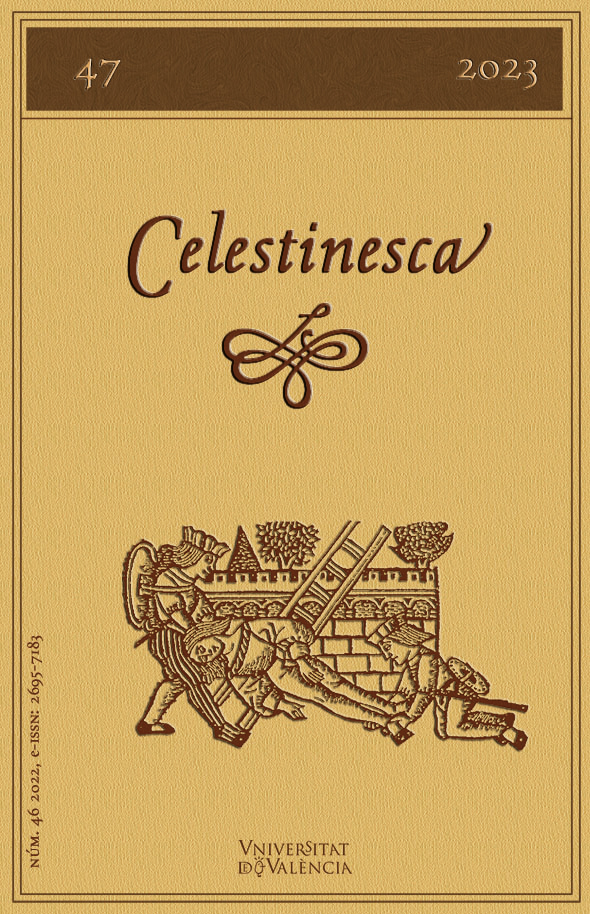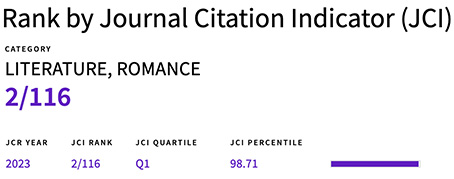Dismantling evil: an analysis of Celestina's resilience
DOI:
https://doi.org/10.7203/Celestinesca.47.25865Keywords:
La Celestina, evil, witch-hunting, patriarchy, gender relations, feminism Abstract
Abstract
Since the publication of La Celestina, the work’s eponymous character has become entrenched as the quintessential malevolent witch figure in Hispanic popular culture. Nevertheless, I contend that to truly understand Celestina, we must take into account the sociopolitical influences of 15th-century Spain that shaped her personality. I therefore propose a re-reading of Fernando de Roja’s work, in which I consider the external forces that render Celestina a profoundly intricate, paradoxical subject. This essay challenges the notion of Celestina’s inherent wickedness, consequentially shedding light on her enduring resilience. While the officios she performs carry a stigma, they simultaneously fuel her ascent to power. By drawing on Silvia Federici’s theoretical framework, I evidence that while Celestina—inhabiting a female body—faces hurdles in translating her ambition, knowledge, and experience to authority, status, and power within the novel’s patriarchal society, the character’s defiant attitude renders her a disruptor of societal norms. Furthermore, this work delves into the motivations that led Rojas to depict Celestina ambivalently; I conclude with the hypothesis that the author projects his own converso anxieties onto the work’s complex character.
 Downloads
Downloads
 References
References
Abril-Sánchez, Jorge. “Una familia de meretrices: prostitutas públicas y privadas, cortesanas, rameras, y putas viejas en Celestina”. Celestinesca, 27, 2003, pp. 7-24. https://doi.org/10.7203/Celestinesca.27.20015
Beusterien, John. "Chapter 16. The Celebratory Conical Hat in La Celestina". Crime and Punishment in the Middle Ages and Early Modern Age: Mental-Historical Investigations of Basic Human Problems and Social Responses, ed. Albrecht Classen y Connie Scarborough. De Gruyter, 2012, pp. 403-414. https://doi.org/10.1515/9783110294583.403
Caro Baroja, Julio. Las brujas y su mundo. Alianza Editorial, 2003.
Del Río Gabiola, Irune. “La Celestina o la normatividad fallida”. Celestinesca, 27, 2021, pp. 61-74. https://doi.org/10.7203/Celestinesca.27.20020
Deyermond, Alan. "Hacia una lectura feminista de La Celestina", Medievalia, 40, 2008, pp. 74-85. https://doi.org/10.19130/medievalia.40.2008.236
Federici, Silvia. Witches, Witch-Hunting, and Women. PM, 2018.
Gabriel, John P. “Reading La Celestina from a Fin De Siglo Feminist Perspective”. Symposium: A Quarterly Journal in Modern Literatures, 54:3, 2000, pp. 160-168. https://doi.org/10.1080/00397700009598296
Gómez Goyzueta, Ximena. “De viva y vieja voz: Celestina por sí misma”. Celestinesca, 40, 2021, pp. 73-86. https://doi.org/10.7203/Celestinesca.40.20192
Granja Ibarreche, Xabier. “Woman reclaimed: Subverting feminine exclusion in the works of María de Zayas in seventeenth-century Spain”. Women and the Ideology of Political Exclusion, ed. Tatiana Tsakiropoulou-Summers y Katerína Kítsī-Mytákou. Routledge, 2019, pp. 234-246.
Herrero, Javier. “Celestina and the Aging Prostitute as Witch”. Aging in Literature, ed. Lauren Porter y Laurence M. Porter. Michigan State University, 1984. pp. 31-47.
Juárez Almendros, Encarnación. “Aging Women and Disability in Early Modern Spanish Literature”. Disability in the Middle Ages: Reconsiderations and Reverberations, ed. Joshua R. Eyler. Ashgate, 2010. pp. 197-208.
Lacarra, María Eugenia. "Evolución de la prostitución en Castilla y la mancebía de Salamanca en tiempos de Fernando de Rojas”. Fernando de Rojas and "Celestina": Approaching the Fith Centenary, ed. Ivy Corfis y Joseph Snow. HSMS, 1993, pp. 33-78.
Moral de Calatrava, Paloma. “Magic or Science?: What 'Old Women Lapidaries' Knew in the Age of Celestina”. La Corónica: A Journal of Medieval Hispanic Languages, Literatures, and Cultures, 36:1, 2007, pp. 203-235. https://doi.org/10.1353/cor.2007.0017
Rojas, Fernando de. La Celestina: Tragicomedia De Calisto y Melibea, ed. Dorothy Severin. Alianza Editorial, 2000.
Rojas, Fernando de. La Celestina, ed. Santiago López-Ríos. Penguin Random House LLC, 2020.
Rouhi, Leyla. “‘...Y Otros Treynta Officios’: The Definition of a Medieval Woman’s Work in Celestina”. Celestinesca, 22:2, 1998, pp. 21–31. https://doi.org/10.7203/Celestinesca.22.19915
Russell, P. E.. “La magia, tema integral de La Celestina". Temas de "La Celestina" y otros estudios: del "Cid" al "Quijote", Ariel, 1978, pp. 241-276. Versión digital de la Biblioteca Virtual Miguel de Cervantes, 2003. https://www.cervantesvirtual.com/nd/ark:/59851/bmcw9538
Sanz, Jacobo. “Una vieja barbuda que se dice Celestina: Notas acerca de la primera caracterización de Celestina”. Celestinesca, 18:1, 1994, pp. 18-34. https://doi.org/10.7203/Celestinesca.18.19843
Severin, Dorothy S.. “Celestina and the Magical Empowerment of Women”. Celestinesca, 17:2, 1993, pp. 9–28. https://doi.org/10.7203/Celestinesca.17.19832
Severin, Dorothy S.. “Witchcraft in Celestina: A Bibliographic Update Since 1995”. La Corónica: A Journal of Medieval Hispanic Languages, Literatures, and Cultures, 36, 2007. pp. 237-243. https://doi.org/10.1353/cor.2007.0020
Swietlicki, Catherine. “Rojas’ View of Women: A Reanalysis of La Celestina”. Hispanófila, 29:1, 1985, pp. 1-13.
Von der Walde, Lillian. “El cuerpo de Celestina: un estudio sobre fisonomía y personalidad”. eHumanista, 9, 2007, pp. 129-142. https://www.ehumanista.ucsb.edu/volumes/9 [accedido el 10/11/2023].
Downloads
Published
How to Cite
-
Abstract320
-
PDF (Español)323
Issue
Section
License
![]() Celestinesca is committed to the dissemination of knowledge, that is why access to its contents is free and is ruled by a Creative Commons Attribution-NonCommercial-NoDerivatives 4.0 license.
Celestinesca is committed to the dissemination of knowledge, that is why access to its contents is free and is ruled by a Creative Commons Attribution-NonCommercial-NoDerivatives 4.0 license.
Authors retain the rights to their works. Therefore, they can disseminate them and deposit them in the repository, institutional or not, that they wish. However, they are kindly requested to do so by providing the full bibliographic reference and the corresponding DOI.
Celestinesca does not charge authors for submitting, processing, reviewing or publishing their articles.





